Training and Development: UK Trends, Theories, and Approaches
VerifiedAdded on 2019/12/03
|14
|4274
|323
Report
AI Summary
This report examines the dynamic field of training and development, with a specific focus on the United Kingdom. It begins by outlining the historical evolution of training methods, from traditional lectures to modern e-learning and mobile-based approaches. The report then delves into key training and development theories, including Kirkpatrick's four-level model, system models, and instructional system development models, analyzing their practical applications and effectiveness in organizations like British Petroleum and John Lewis. Furthermore, it explores various approaches to training, such as systematic and three-fold approaches, and emphasizes the importance of aligning training methods with specific organizational needs. The report also highlights current training trends in the UK, such as on-the-job training, coaching, and the increasing adoption of e-learning, providing insights into how organizations are adapting to meet the challenges of a changing business environment. Finally, the report concludes with a summary of key findings and implications for future training and development practices.
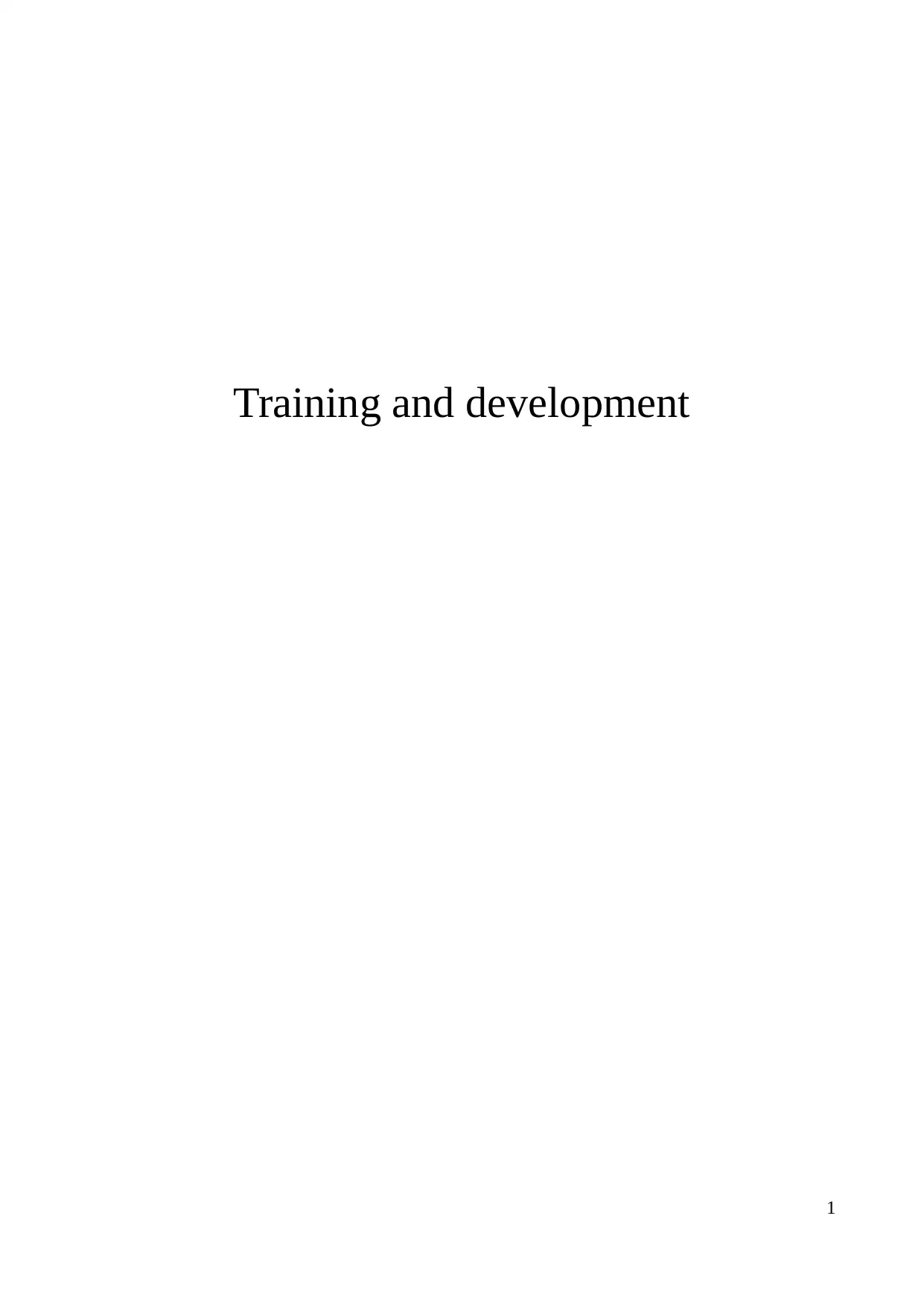
Training and development
1
1
Paraphrase This Document
Need a fresh take? Get an instant paraphrase of this document with our AI Paraphraser
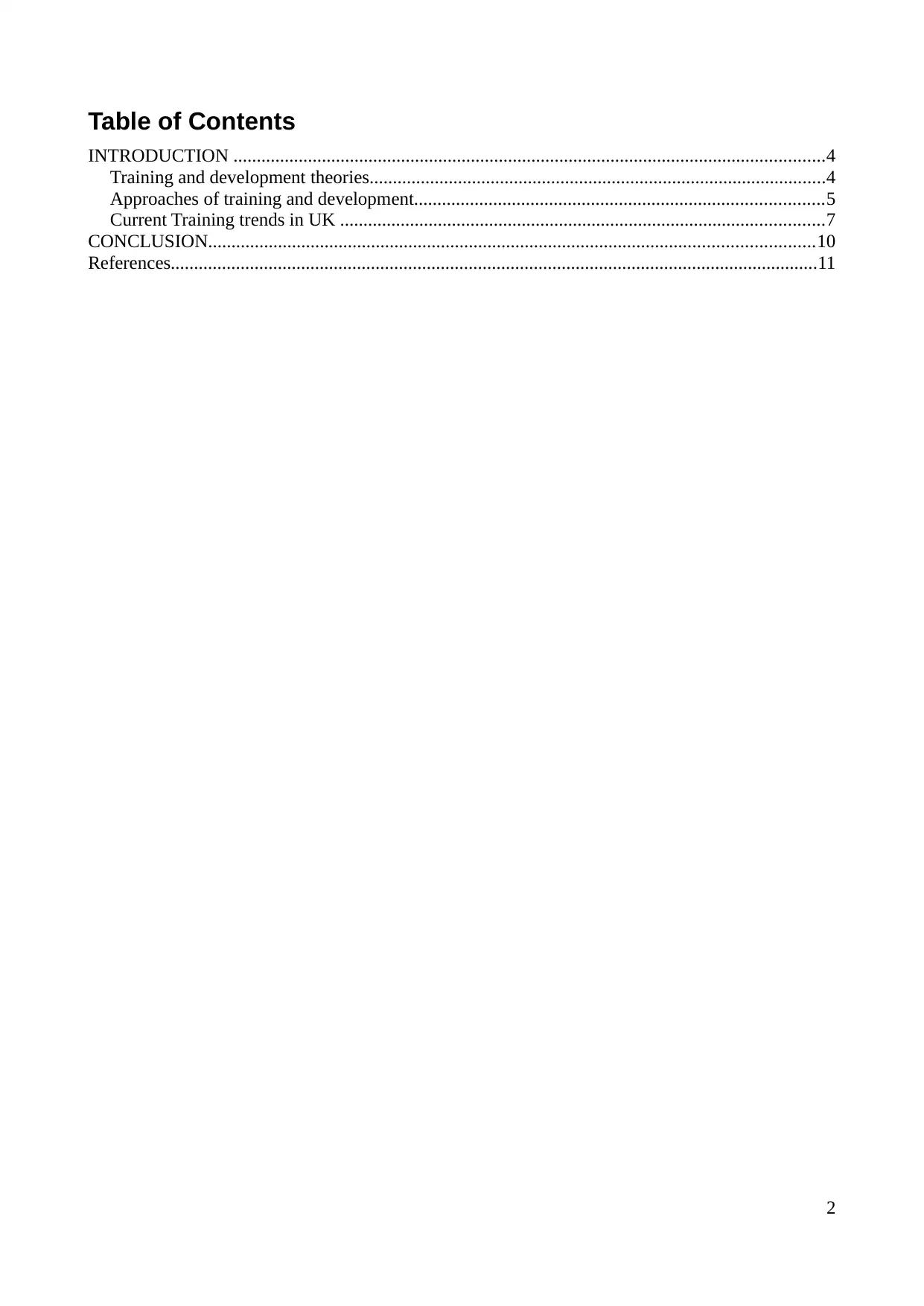
Table of Contents
INTRODUCTION ...............................................................................................................................4
Training and development theories..................................................................................................4
Approaches of training and development........................................................................................5
Current Training trends in UK ........................................................................................................7
CONCLUSION..................................................................................................................................10
References...........................................................................................................................................11
2
INTRODUCTION ...............................................................................................................................4
Training and development theories..................................................................................................4
Approaches of training and development........................................................................................5
Current Training trends in UK ........................................................................................................7
CONCLUSION..................................................................................................................................10
References...........................................................................................................................................11
2
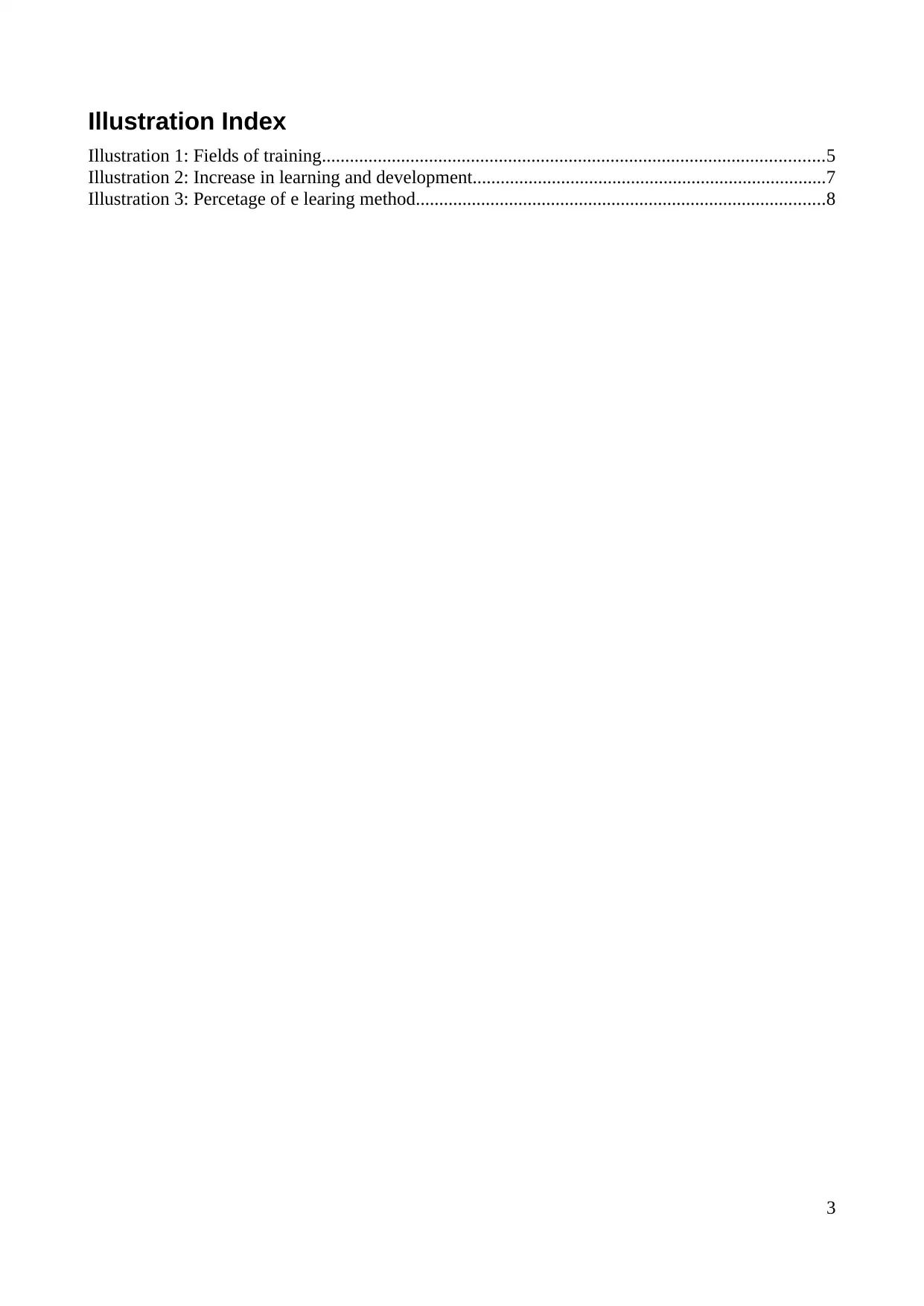
Illustration Index
Illustration 1: Fields of training............................................................................................................5
Illustration 2: Increase in learning and development............................................................................7
Illustration 3: Percetage of e learing method........................................................................................8
3
Illustration 1: Fields of training............................................................................................................5
Illustration 2: Increase in learning and development............................................................................7
Illustration 3: Percetage of e learing method........................................................................................8
3
⊘ This is a preview!⊘
Do you want full access?
Subscribe today to unlock all pages.

Trusted by 1+ million students worldwide
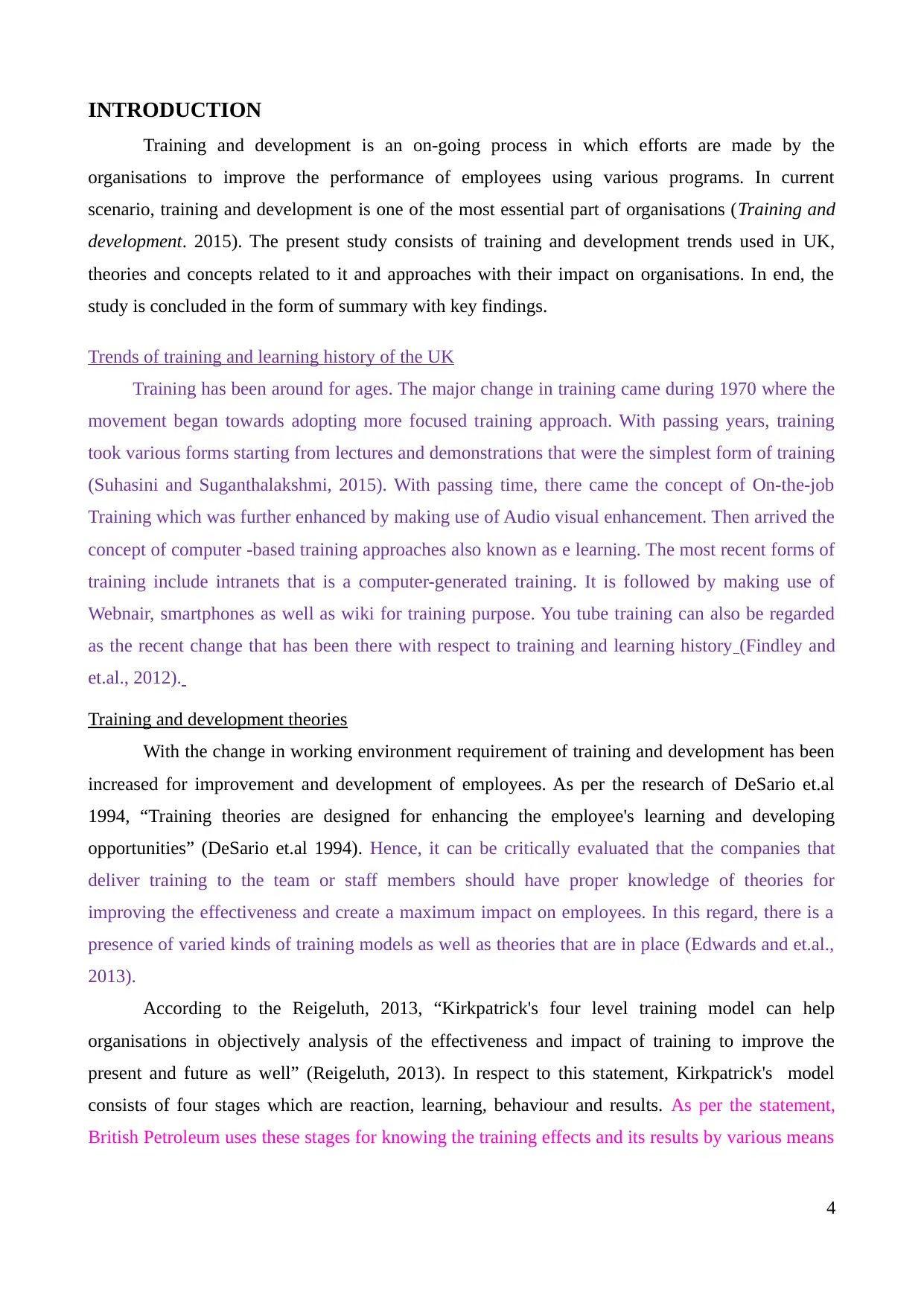
INTRODUCTION
Training and development is an on-going process in which efforts are made by the
organisations to improve the performance of employees using various programs. In current
scenario, training and development is one of the most essential part of organisations (Training and
development. 2015). The present study consists of training and development trends used in UK,
theories and concepts related to it and approaches with their impact on organisations. In end, the
study is concluded in the form of summary with key findings.
Trends of training and learning history of the UK
Training has been around for ages. The major change in training came during 1970 where the
movement began towards adopting more focused training approach. With passing years, training
took various forms starting from lectures and demonstrations that were the simplest form of training
(Suhasini and Suganthalakshmi, 2015). With passing time, there came the concept of On-the-job
Training which was further enhanced by making use of Audio visual enhancement. Then arrived the
concept of computer -based training approaches also known as e learning. The most recent forms of
training include intranets that is a computer-generated training. It is followed by making use of
Webnair, smartphones as well as wiki for training purpose. You tube training can also be regarded
as the recent change that has been there with respect to training and learning history (Findley and
et.al., 2012).
Training and development theories
With the change in working environment requirement of training and development has been
increased for improvement and development of employees. As per the research of DeSario et.al
1994, “Training theories are designed for enhancing the employee's learning and developing
opportunities” (DeSario et.al 1994). Hence, it can be critically evaluated that the companies that
deliver training to the team or staff members should have proper knowledge of theories for
improving the effectiveness and create a maximum impact on employees. In this regard, there is a
presence of varied kinds of training models as well as theories that are in place (Edwards and et.al.,
2013).
According to the Reigeluth, 2013, “Kirkpatrick's four level training model can help
organisations in objectively analysis of the effectiveness and impact of training to improve the
present and future as well” (Reigeluth, 2013). In respect to this statement, Kirkpatrick's model
consists of four stages which are reaction, learning, behaviour and results. As per the statement,
British Petroleum uses these stages for knowing the training effects and its results by various means
4
Training and development is an on-going process in which efforts are made by the
organisations to improve the performance of employees using various programs. In current
scenario, training and development is one of the most essential part of organisations (Training and
development. 2015). The present study consists of training and development trends used in UK,
theories and concepts related to it and approaches with their impact on organisations. In end, the
study is concluded in the form of summary with key findings.
Trends of training and learning history of the UK
Training has been around for ages. The major change in training came during 1970 where the
movement began towards adopting more focused training approach. With passing years, training
took various forms starting from lectures and demonstrations that were the simplest form of training
(Suhasini and Suganthalakshmi, 2015). With passing time, there came the concept of On-the-job
Training which was further enhanced by making use of Audio visual enhancement. Then arrived the
concept of computer -based training approaches also known as e learning. The most recent forms of
training include intranets that is a computer-generated training. It is followed by making use of
Webnair, smartphones as well as wiki for training purpose. You tube training can also be regarded
as the recent change that has been there with respect to training and learning history (Findley and
et.al., 2012).
Training and development theories
With the change in working environment requirement of training and development has been
increased for improvement and development of employees. As per the research of DeSario et.al
1994, “Training theories are designed for enhancing the employee's learning and developing
opportunities” (DeSario et.al 1994). Hence, it can be critically evaluated that the companies that
deliver training to the team or staff members should have proper knowledge of theories for
improving the effectiveness and create a maximum impact on employees. In this regard, there is a
presence of varied kinds of training models as well as theories that are in place (Edwards and et.al.,
2013).
According to the Reigeluth, 2013, “Kirkpatrick's four level training model can help
organisations in objectively analysis of the effectiveness and impact of training to improve the
present and future as well” (Reigeluth, 2013). In respect to this statement, Kirkpatrick's model
consists of four stages which are reaction, learning, behaviour and results. As per the statement,
British Petroleum uses these stages for knowing the training effects and its results by various means
4
Paraphrase This Document
Need a fresh take? Get an instant paraphrase of this document with our AI Paraphraser
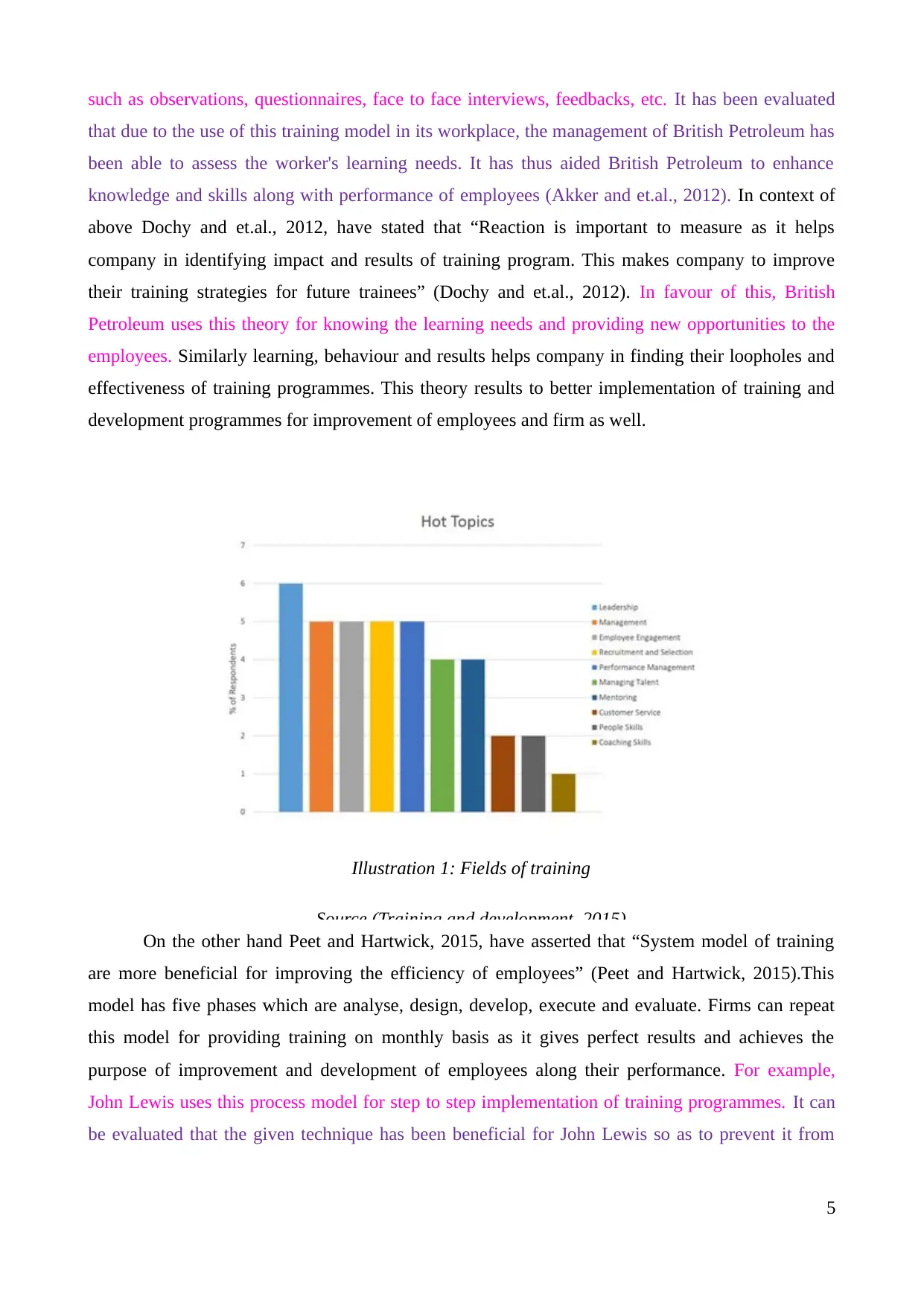
such as observations, questionnaires, face to face interviews, feedbacks, etc. It has been evaluated
that due to the use of this training model in its workplace, the management of British Petroleum has
been able to assess the worker's learning needs. It has thus aided British Petroleum to enhance
knowledge and skills along with performance of employees (Akker and et.al., 2012). In context of
above Dochy and et.al., 2012, have stated that “Reaction is important to measure as it helps
company in identifying impact and results of training program. This makes company to improve
their training strategies for future trainees” (Dochy and et.al., 2012). In favour of this, British
Petroleum uses this theory for knowing the learning needs and providing new opportunities to the
employees. Similarly learning, behaviour and results helps company in finding their loopholes and
effectiveness of training programmes. This theory results to better implementation of training and
development programmes for improvement of employees and firm as well.
On the other hand Peet and Hartwick, 2015, have asserted that “System model of training
are more beneficial for improving the efficiency of employees” (Peet and Hartwick, 2015).This
model has five phases which are analyse, design, develop, execute and evaluate. Firms can repeat
this model for providing training on monthly basis as it gives perfect results and achieves the
purpose of improvement and development of employees along their performance. For example,
John Lewis uses this process model for step to step implementation of training programmes. It can
be evaluated that the given technique has been beneficial for John Lewis so as to prevent it from
5
Illustration 1: Fields of training
Source (Training and development. 2015)
that due to the use of this training model in its workplace, the management of British Petroleum has
been able to assess the worker's learning needs. It has thus aided British Petroleum to enhance
knowledge and skills along with performance of employees (Akker and et.al., 2012). In context of
above Dochy and et.al., 2012, have stated that “Reaction is important to measure as it helps
company in identifying impact and results of training program. This makes company to improve
their training strategies for future trainees” (Dochy and et.al., 2012). In favour of this, British
Petroleum uses this theory for knowing the learning needs and providing new opportunities to the
employees. Similarly learning, behaviour and results helps company in finding their loopholes and
effectiveness of training programmes. This theory results to better implementation of training and
development programmes for improvement of employees and firm as well.
On the other hand Peet and Hartwick, 2015, have asserted that “System model of training
are more beneficial for improving the efficiency of employees” (Peet and Hartwick, 2015).This
model has five phases which are analyse, design, develop, execute and evaluate. Firms can repeat
this model for providing training on monthly basis as it gives perfect results and achieves the
purpose of improvement and development of employees along their performance. For example,
John Lewis uses this process model for step to step implementation of training programmes. It can
be evaluated that the given technique has been beneficial for John Lewis so as to prevent it from
5
Illustration 1: Fields of training
Source (Training and development. 2015)
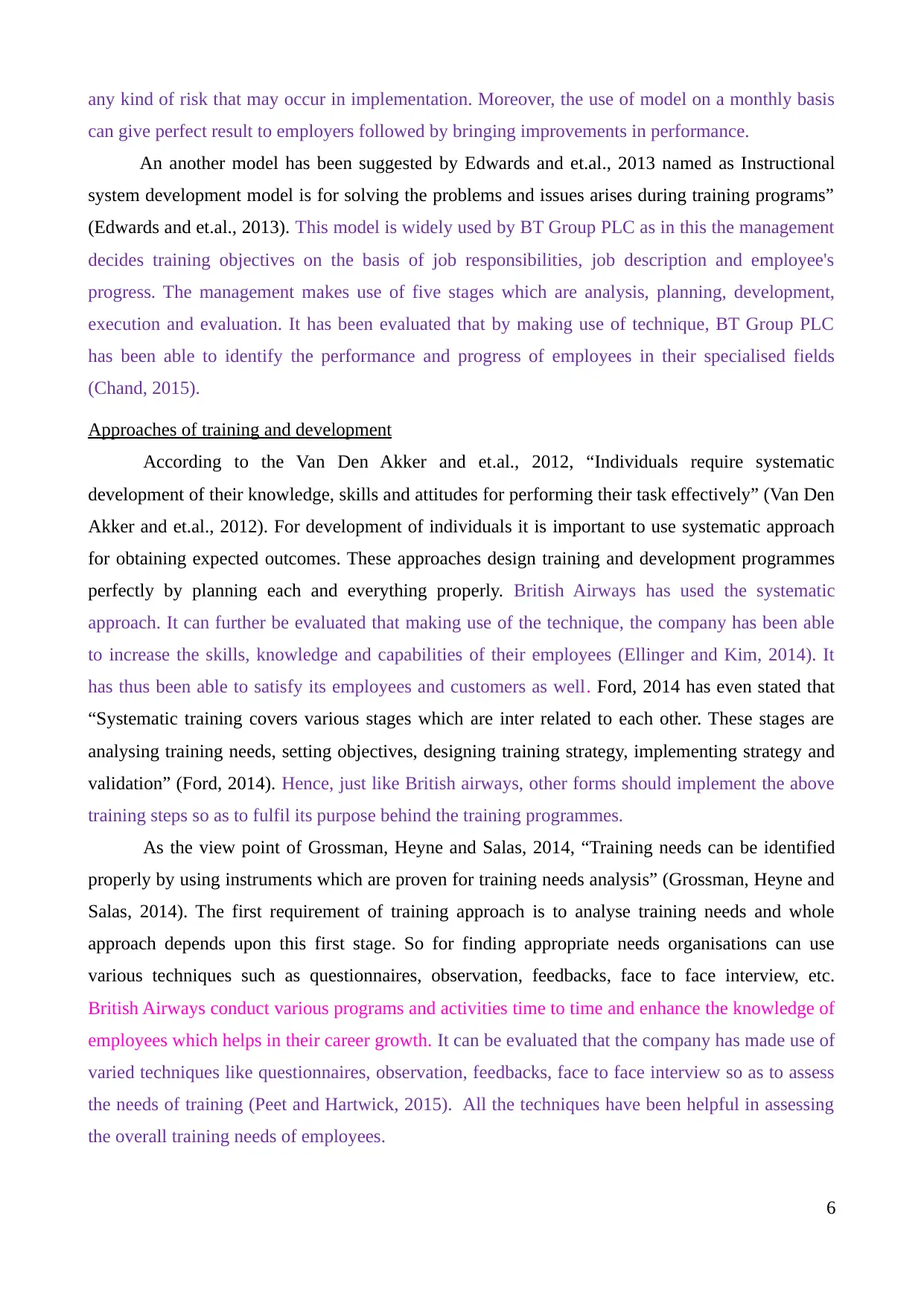
any kind of risk that may occur in implementation. Moreover, the use of model on a monthly basis
can give perfect result to employers followed by bringing improvements in performance.
An another model has been suggested by Edwards and et.al., 2013 named as Instructional
system development model is for solving the problems and issues arises during training programs”
(Edwards and et.al., 2013). This model is widely used by BT Group PLC as in this the management
decides training objectives on the basis of job responsibilities, job description and employee's
progress. The management makes use of five stages which are analysis, planning, development,
execution and evaluation. It has been evaluated that by making use of technique, BT Group PLC
has been able to identify the performance and progress of employees in their specialised fields
(Chand, 2015).
Approaches of training and development
According to the Van Den Akker and et.al., 2012, “Individuals require systematic
development of their knowledge, skills and attitudes for performing their task effectively” (Van Den
Akker and et.al., 2012). For development of individuals it is important to use systematic approach
for obtaining expected outcomes. These approaches design training and development programmes
perfectly by planning each and everything properly. British Airways has used the systematic
approach. It can further be evaluated that making use of the technique, the company has been able
to increase the skills, knowledge and capabilities of their employees (Ellinger and Kim, 2014). It
has thus been able to satisfy its employees and customers as well. Ford, 2014 has even stated that
“Systematic training covers various stages which are inter related to each other. These stages are
analysing training needs, setting objectives, designing training strategy, implementing strategy and
validation” (Ford, 2014). Hence, just like British airways, other forms should implement the above
training steps so as to fulfil its purpose behind the training programmes.
As the view point of Grossman, Heyne and Salas, 2014, “Training needs can be identified
properly by using instruments which are proven for training needs analysis” (Grossman, Heyne and
Salas, 2014). The first requirement of training approach is to analyse training needs and whole
approach depends upon this first stage. So for finding appropriate needs organisations can use
various techniques such as questionnaires, observation, feedbacks, face to face interview, etc.
British Airways conduct various programs and activities time to time and enhance the knowledge of
employees which helps in their career growth. It can be evaluated that the company has made use of
varied techniques like questionnaires, observation, feedbacks, face to face interview so as to assess
the needs of training (Peet and Hartwick, 2015). All the techniques have been helpful in assessing
the overall training needs of employees.
6
can give perfect result to employers followed by bringing improvements in performance.
An another model has been suggested by Edwards and et.al., 2013 named as Instructional
system development model is for solving the problems and issues arises during training programs”
(Edwards and et.al., 2013). This model is widely used by BT Group PLC as in this the management
decides training objectives on the basis of job responsibilities, job description and employee's
progress. The management makes use of five stages which are analysis, planning, development,
execution and evaluation. It has been evaluated that by making use of technique, BT Group PLC
has been able to identify the performance and progress of employees in their specialised fields
(Chand, 2015).
Approaches of training and development
According to the Van Den Akker and et.al., 2012, “Individuals require systematic
development of their knowledge, skills and attitudes for performing their task effectively” (Van Den
Akker and et.al., 2012). For development of individuals it is important to use systematic approach
for obtaining expected outcomes. These approaches design training and development programmes
perfectly by planning each and everything properly. British Airways has used the systematic
approach. It can further be evaluated that making use of the technique, the company has been able
to increase the skills, knowledge and capabilities of their employees (Ellinger and Kim, 2014). It
has thus been able to satisfy its employees and customers as well. Ford, 2014 has even stated that
“Systematic training covers various stages which are inter related to each other. These stages are
analysing training needs, setting objectives, designing training strategy, implementing strategy and
validation” (Ford, 2014). Hence, just like British airways, other forms should implement the above
training steps so as to fulfil its purpose behind the training programmes.
As the view point of Grossman, Heyne and Salas, 2014, “Training needs can be identified
properly by using instruments which are proven for training needs analysis” (Grossman, Heyne and
Salas, 2014). The first requirement of training approach is to analyse training needs and whole
approach depends upon this first stage. So for finding appropriate needs organisations can use
various techniques such as questionnaires, observation, feedbacks, face to face interview, etc.
British Airways conduct various programs and activities time to time and enhance the knowledge of
employees which helps in their career growth. It can be evaluated that the company has made use of
varied techniques like questionnaires, observation, feedbacks, face to face interview so as to assess
the needs of training (Peet and Hartwick, 2015). All the techniques have been helpful in assessing
the overall training needs of employees.
6
⊘ This is a preview!⊘
Do you want full access?
Subscribe today to unlock all pages.

Trusted by 1+ million students worldwide
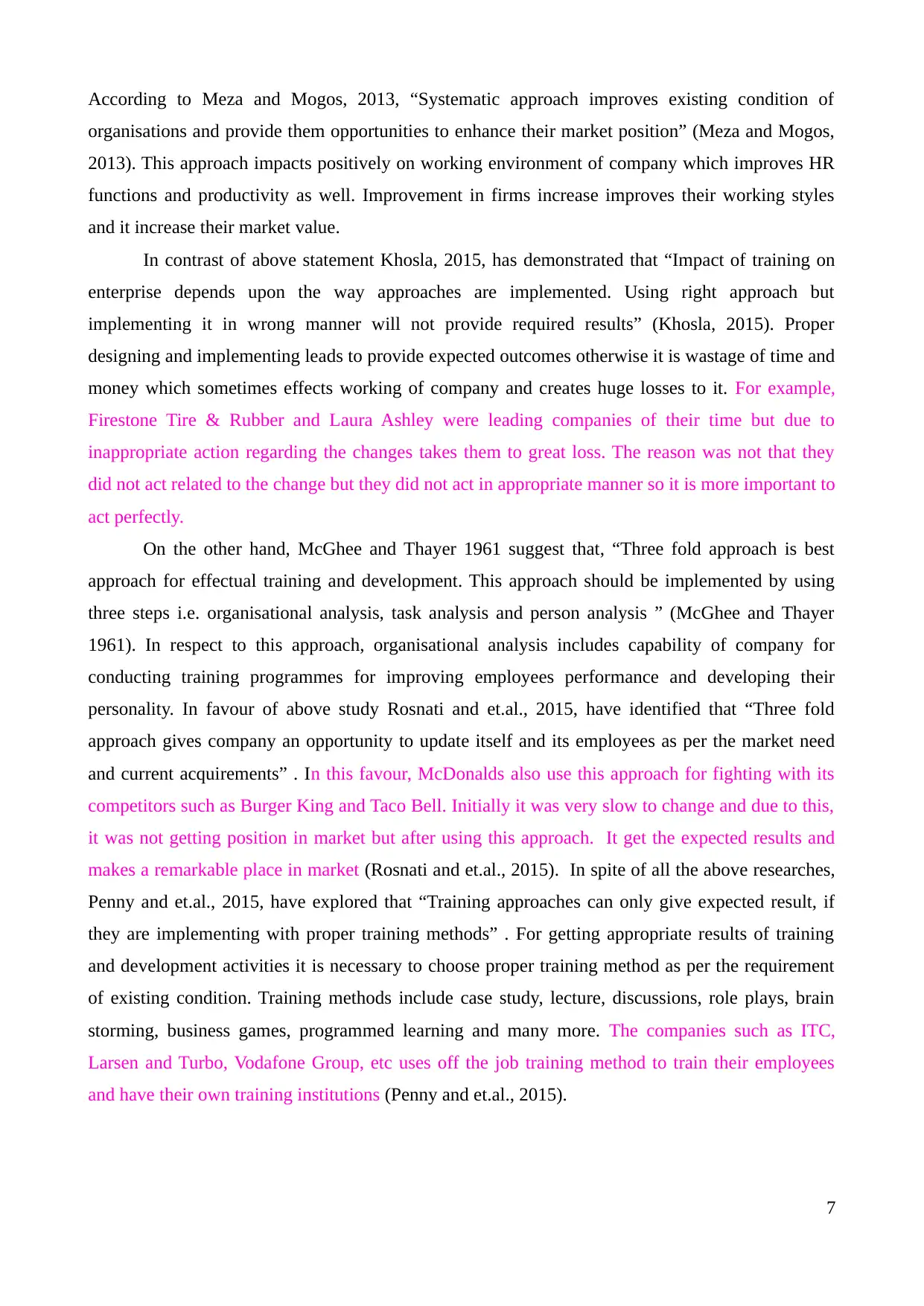
According to Meza and Mogos, 2013, “Systematic approach improves existing condition of
organisations and provide them opportunities to enhance their market position” (Meza and Mogos,
2013). This approach impacts positively on working environment of company which improves HR
functions and productivity as well. Improvement in firms increase improves their working styles
and it increase their market value.
In contrast of above statement Khosla, 2015, has demonstrated that “Impact of training on
enterprise depends upon the way approaches are implemented. Using right approach but
implementing it in wrong manner will not provide required results” (Khosla, 2015). Proper
designing and implementing leads to provide expected outcomes otherwise it is wastage of time and
money which sometimes effects working of company and creates huge losses to it. For example,
Firestone Tire & Rubber and Laura Ashley were leading companies of their time but due to
inappropriate action regarding the changes takes them to great loss. The reason was not that they
did not act related to the change but they did not act in appropriate manner so it is more important to
act perfectly.
On the other hand, McGhee and Thayer 1961 suggest that, “Three fold approach is best
approach for effectual training and development. This approach should be implemented by using
three steps i.e. organisational analysis, task analysis and person analysis ” (McGhee and Thayer
1961). In respect to this approach, organisational analysis includes capability of company for
conducting training programmes for improving employees performance and developing their
personality. In favour of above study Rosnati and et.al., 2015, have identified that “Three fold
approach gives company an opportunity to update itself and its employees as per the market need
and current acquirements” . In this favour, McDonalds also use this approach for fighting with its
competitors such as Burger King and Taco Bell. Initially it was very slow to change and due to this,
it was not getting position in market but after using this approach. It get the expected results and
makes a remarkable place in market (Rosnati and et.al., 2015). In spite of all the above researches,
Penny and et.al., 2015, have explored that “Training approaches can only give expected result, if
they are implementing with proper training methods” . For getting appropriate results of training
and development activities it is necessary to choose proper training method as per the requirement
of existing condition. Training methods include case study, lecture, discussions, role plays, brain
storming, business games, programmed learning and many more. The companies such as ITC,
Larsen and Turbo, Vodafone Group, etc uses off the job training method to train their employees
and have their own training institutions (Penny and et.al., 2015).
7
organisations and provide them opportunities to enhance their market position” (Meza and Mogos,
2013). This approach impacts positively on working environment of company which improves HR
functions and productivity as well. Improvement in firms increase improves their working styles
and it increase their market value.
In contrast of above statement Khosla, 2015, has demonstrated that “Impact of training on
enterprise depends upon the way approaches are implemented. Using right approach but
implementing it in wrong manner will not provide required results” (Khosla, 2015). Proper
designing and implementing leads to provide expected outcomes otherwise it is wastage of time and
money which sometimes effects working of company and creates huge losses to it. For example,
Firestone Tire & Rubber and Laura Ashley were leading companies of their time but due to
inappropriate action regarding the changes takes them to great loss. The reason was not that they
did not act related to the change but they did not act in appropriate manner so it is more important to
act perfectly.
On the other hand, McGhee and Thayer 1961 suggest that, “Three fold approach is best
approach for effectual training and development. This approach should be implemented by using
three steps i.e. organisational analysis, task analysis and person analysis ” (McGhee and Thayer
1961). In respect to this approach, organisational analysis includes capability of company for
conducting training programmes for improving employees performance and developing their
personality. In favour of above study Rosnati and et.al., 2015, have identified that “Three fold
approach gives company an opportunity to update itself and its employees as per the market need
and current acquirements” . In this favour, McDonalds also use this approach for fighting with its
competitors such as Burger King and Taco Bell. Initially it was very slow to change and due to this,
it was not getting position in market but after using this approach. It get the expected results and
makes a remarkable place in market (Rosnati and et.al., 2015). In spite of all the above researches,
Penny and et.al., 2015, have explored that “Training approaches can only give expected result, if
they are implementing with proper training methods” . For getting appropriate results of training
and development activities it is necessary to choose proper training method as per the requirement
of existing condition. Training methods include case study, lecture, discussions, role plays, brain
storming, business games, programmed learning and many more. The companies such as ITC,
Larsen and Turbo, Vodafone Group, etc uses off the job training method to train their employees
and have their own training institutions (Penny and et.al., 2015).
7
Paraphrase This Document
Need a fresh take? Get an instant paraphrase of this document with our AI Paraphraser
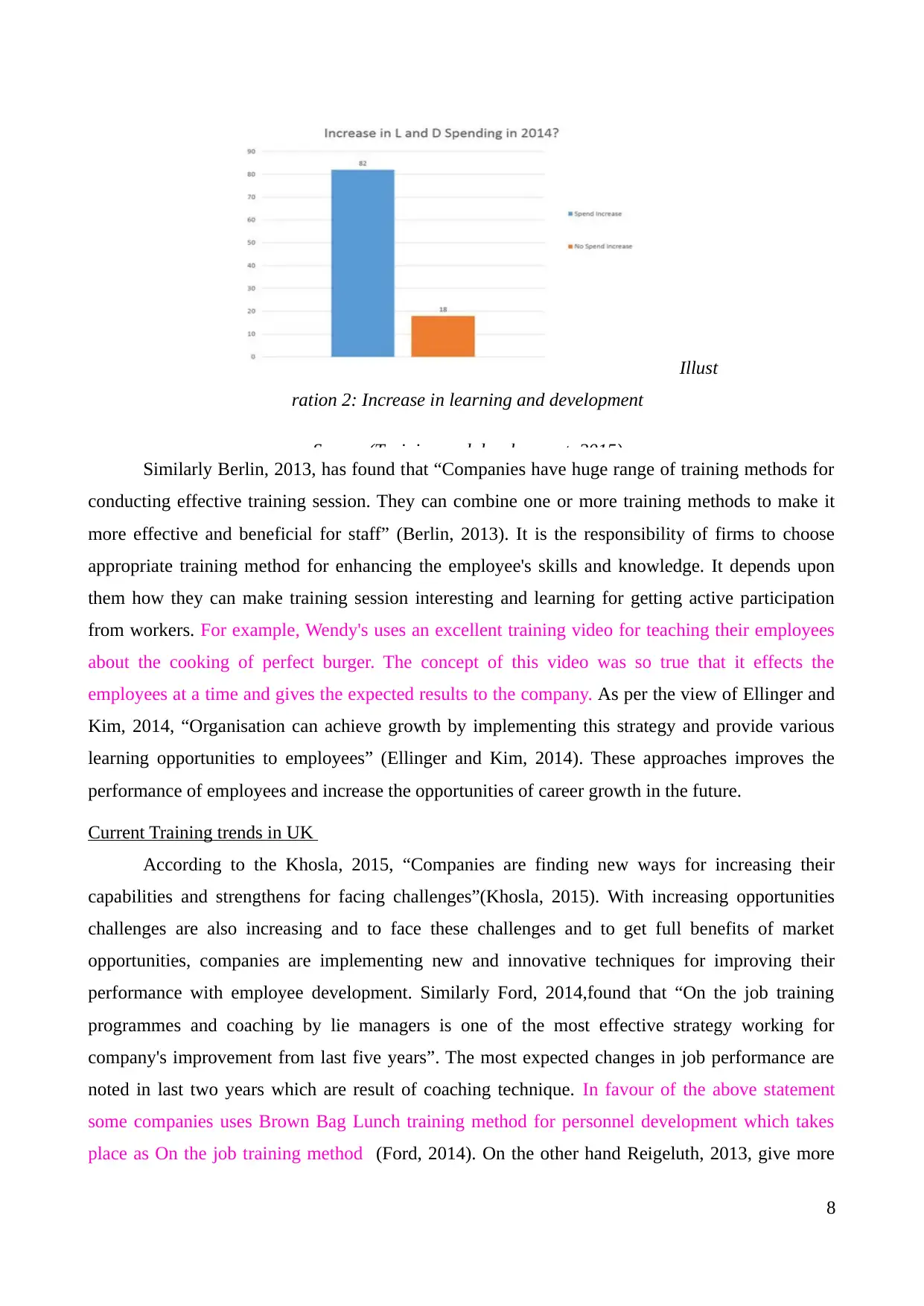
Similarly Berlin, 2013, has found that “Companies have huge range of training methods for
conducting effective training session. They can combine one or more training methods to make it
more effective and beneficial for staff” (Berlin, 2013). It is the responsibility of firms to choose
appropriate training method for enhancing the employee's skills and knowledge. It depends upon
them how they can make training session interesting and learning for getting active participation
from workers. For example, Wendy's uses an excellent training video for teaching their employees
about the cooking of perfect burger. The concept of this video was so true that it effects the
employees at a time and gives the expected results to the company. As per the view of Ellinger and
Kim, 2014, “Organisation can achieve growth by implementing this strategy and provide various
learning opportunities to employees” (Ellinger and Kim, 2014). These approaches improves the
performance of employees and increase the opportunities of career growth in the future.
Current Training trends in UK
According to the Khosla, 2015, “Companies are finding new ways for increasing their
capabilities and strengthens for facing challenges”(Khosla, 2015). With increasing opportunities
challenges are also increasing and to face these challenges and to get full benefits of market
opportunities, companies are implementing new and innovative techniques for improving their
performance with employee development. Similarly Ford, 2014,found that “On the job training
programmes and coaching by lie managers is one of the most effective strategy working for
company's improvement from last five years”. The most expected changes in job performance are
noted in last two years which are result of coaching technique. In favour of the above statement
some companies uses Brown Bag Lunch training method for personnel development which takes
place as On the job training method (Ford, 2014). On the other hand Reigeluth, 2013, give more
8
Illust
ration 2: Increase in learning and development
Source (Training and development. 2015)
conducting effective training session. They can combine one or more training methods to make it
more effective and beneficial for staff” (Berlin, 2013). It is the responsibility of firms to choose
appropriate training method for enhancing the employee's skills and knowledge. It depends upon
them how they can make training session interesting and learning for getting active participation
from workers. For example, Wendy's uses an excellent training video for teaching their employees
about the cooking of perfect burger. The concept of this video was so true that it effects the
employees at a time and gives the expected results to the company. As per the view of Ellinger and
Kim, 2014, “Organisation can achieve growth by implementing this strategy and provide various
learning opportunities to employees” (Ellinger and Kim, 2014). These approaches improves the
performance of employees and increase the opportunities of career growth in the future.
Current Training trends in UK
According to the Khosla, 2015, “Companies are finding new ways for increasing their
capabilities and strengthens for facing challenges”(Khosla, 2015). With increasing opportunities
challenges are also increasing and to face these challenges and to get full benefits of market
opportunities, companies are implementing new and innovative techniques for improving their
performance with employee development. Similarly Ford, 2014,found that “On the job training
programmes and coaching by lie managers is one of the most effective strategy working for
company's improvement from last five years”. The most expected changes in job performance are
noted in last two years which are result of coaching technique. In favour of the above statement
some companies uses Brown Bag Lunch training method for personnel development which takes
place as On the job training method (Ford, 2014). On the other hand Reigeluth, 2013, give more
8
Illust
ration 2: Increase in learning and development
Source (Training and development. 2015)
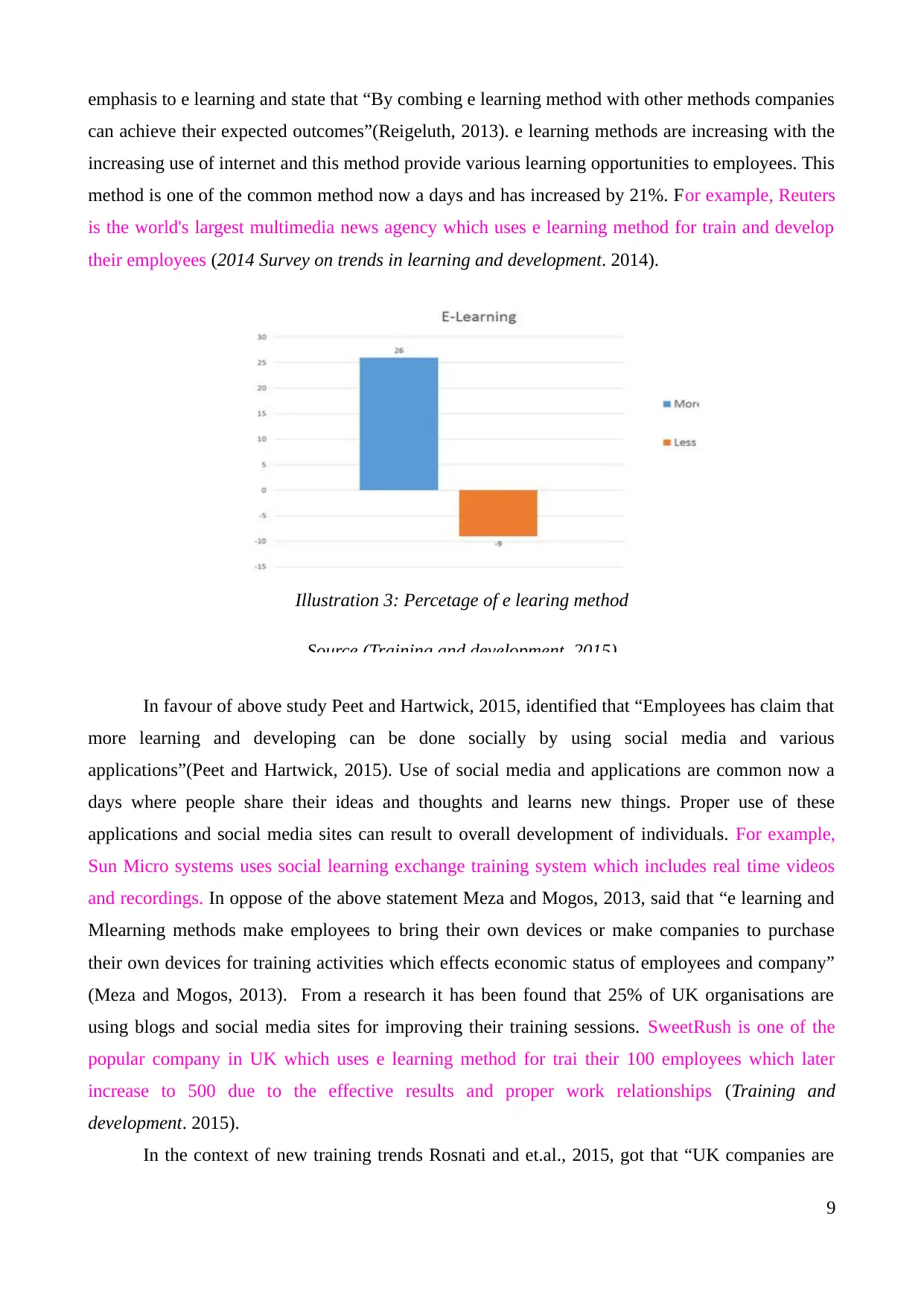
emphasis to e learning and state that “By combing e learning method with other methods companies
can achieve their expected outcomes”(Reigeluth, 2013). e learning methods are increasing with the
increasing use of internet and this method provide various learning opportunities to employees. This
method is one of the common method now a days and has increased by 21%. For example, Reuters
is the world's largest multimedia news agency which uses e learning method for train and develop
their employees (2014 Survey on trends in learning and development. 2014).
In favour of above study Peet and Hartwick, 2015, identified that “Employees has claim that
more learning and developing can be done socially by using social media and various
applications”(Peet and Hartwick, 2015). Use of social media and applications are common now a
days where people share their ideas and thoughts and learns new things. Proper use of these
applications and social media sites can result to overall development of individuals. For example,
Sun Micro systems uses social learning exchange training system which includes real time videos
and recordings. In oppose of the above statement Meza and Mogos, 2013, said that “e learning and
Mlearning methods make employees to bring their own devices or make companies to purchase
their own devices for training activities which effects economic status of employees and company”
(Meza and Mogos, 2013). From a research it has been found that 25% of UK organisations are
using blogs and social media sites for improving their training sessions. SweetRush is one of the
popular company in UK which uses e learning method for trai their 100 employees which later
increase to 500 due to the effective results and proper work relationships (Training and
development. 2015).
In the context of new training trends Rosnati and et.al., 2015, got that “UK companies are
9
Illustration 3: Percetage of e learing method
Source (Training and development. 2015)
can achieve their expected outcomes”(Reigeluth, 2013). e learning methods are increasing with the
increasing use of internet and this method provide various learning opportunities to employees. This
method is one of the common method now a days and has increased by 21%. For example, Reuters
is the world's largest multimedia news agency which uses e learning method for train and develop
their employees (2014 Survey on trends in learning and development. 2014).
In favour of above study Peet and Hartwick, 2015, identified that “Employees has claim that
more learning and developing can be done socially by using social media and various
applications”(Peet and Hartwick, 2015). Use of social media and applications are common now a
days where people share their ideas and thoughts and learns new things. Proper use of these
applications and social media sites can result to overall development of individuals. For example,
Sun Micro systems uses social learning exchange training system which includes real time videos
and recordings. In oppose of the above statement Meza and Mogos, 2013, said that “e learning and
Mlearning methods make employees to bring their own devices or make companies to purchase
their own devices for training activities which effects economic status of employees and company”
(Meza and Mogos, 2013). From a research it has been found that 25% of UK organisations are
using blogs and social media sites for improving their training sessions. SweetRush is one of the
popular company in UK which uses e learning method for trai their 100 employees which later
increase to 500 due to the effective results and proper work relationships (Training and
development. 2015).
In the context of new training trends Rosnati and et.al., 2015, got that “UK companies are
9
Illustration 3: Percetage of e learing method
Source (Training and development. 2015)
⊘ This is a preview!⊘
Do you want full access?
Subscribe today to unlock all pages.

Trusted by 1+ million students worldwide
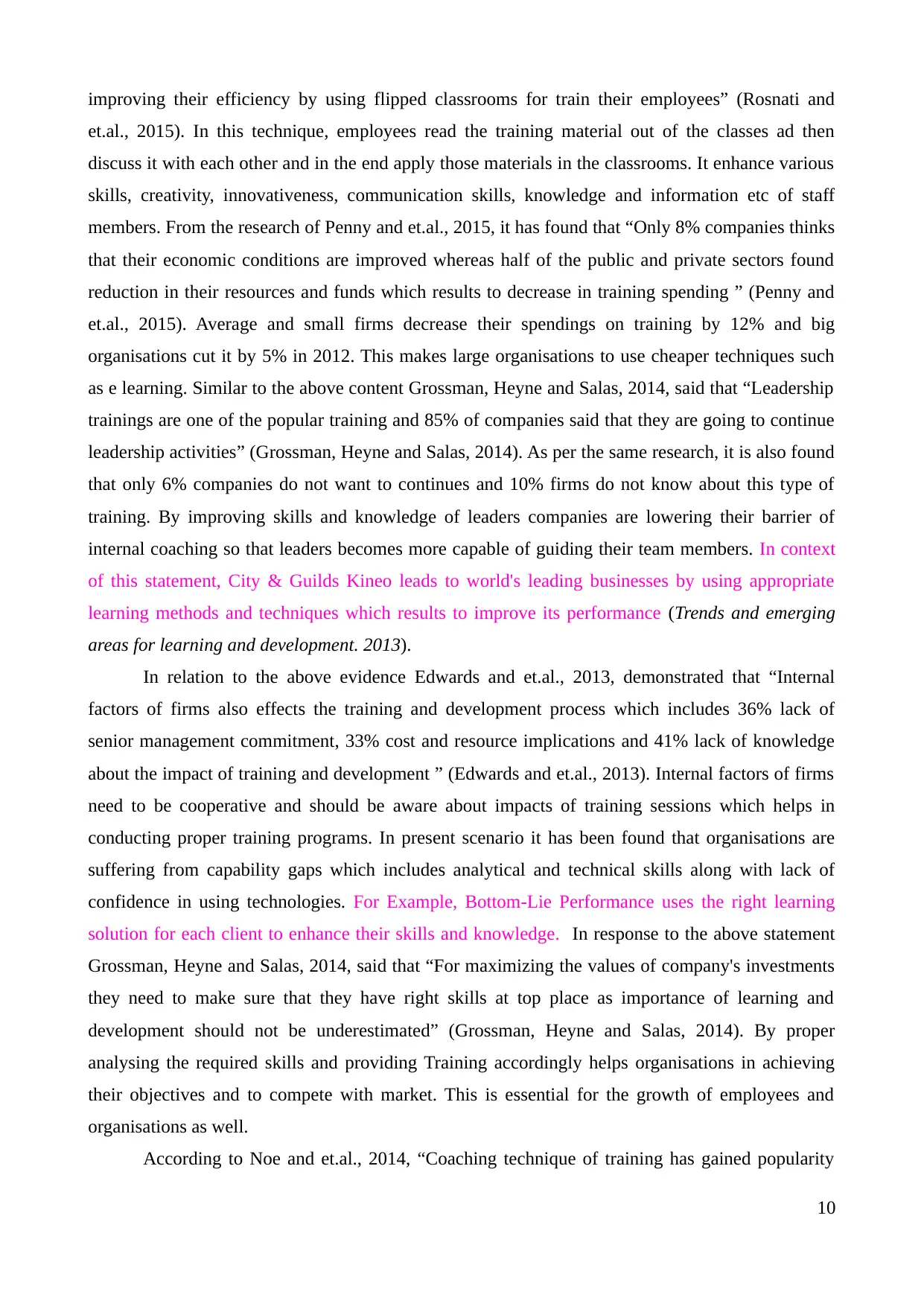
improving their efficiency by using flipped classrooms for train their employees” (Rosnati and
et.al., 2015). In this technique, employees read the training material out of the classes ad then
discuss it with each other and in the end apply those materials in the classrooms. It enhance various
skills, creativity, innovativeness, communication skills, knowledge and information etc of staff
members. From the research of Penny and et.al., 2015, it has found that “Only 8% companies thinks
that their economic conditions are improved whereas half of the public and private sectors found
reduction in their resources and funds which results to decrease in training spending ” (Penny and
et.al., 2015). Average and small firms decrease their spendings on training by 12% and big
organisations cut it by 5% in 2012. This makes large organisations to use cheaper techniques such
as e learning. Similar to the above content Grossman, Heyne and Salas, 2014, said that “Leadership
trainings are one of the popular training and 85% of companies said that they are going to continue
leadership activities” (Grossman, Heyne and Salas, 2014). As per the same research, it is also found
that only 6% companies do not want to continues and 10% firms do not know about this type of
training. By improving skills and knowledge of leaders companies are lowering their barrier of
internal coaching so that leaders becomes more capable of guiding their team members. In context
of this statement, City & Guilds Kineo leads to world's leading businesses by using appropriate
learning methods and techniques which results to improve its performance (Trends and emerging
areas for learning and development. 2013).
In relation to the above evidence Edwards and et.al., 2013, demonstrated that “Internal
factors of firms also effects the training and development process which includes 36% lack of
senior management commitment, 33% cost and resource implications and 41% lack of knowledge
about the impact of training and development ” (Edwards and et.al., 2013). Internal factors of firms
need to be cooperative and should be aware about impacts of training sessions which helps in
conducting proper training programs. In present scenario it has been found that organisations are
suffering from capability gaps which includes analytical and technical skills along with lack of
confidence in using technologies. For Example, Bottom-Lie Performance uses the right learning
solution for each client to enhance their skills and knowledge. In response to the above statement
Grossman, Heyne and Salas, 2014, said that “For maximizing the values of company's investments
they need to make sure that they have right skills at top place as importance of learning and
development should not be underestimated” (Grossman, Heyne and Salas, 2014). By proper
analysing the required skills and providing Training accordingly helps organisations in achieving
their objectives and to compete with market. This is essential for the growth of employees and
organisations as well.
According to Noe and et.al., 2014, “Coaching technique of training has gained popularity
10
et.al., 2015). In this technique, employees read the training material out of the classes ad then
discuss it with each other and in the end apply those materials in the classrooms. It enhance various
skills, creativity, innovativeness, communication skills, knowledge and information etc of staff
members. From the research of Penny and et.al., 2015, it has found that “Only 8% companies thinks
that their economic conditions are improved whereas half of the public and private sectors found
reduction in their resources and funds which results to decrease in training spending ” (Penny and
et.al., 2015). Average and small firms decrease their spendings on training by 12% and big
organisations cut it by 5% in 2012. This makes large organisations to use cheaper techniques such
as e learning. Similar to the above content Grossman, Heyne and Salas, 2014, said that “Leadership
trainings are one of the popular training and 85% of companies said that they are going to continue
leadership activities” (Grossman, Heyne and Salas, 2014). As per the same research, it is also found
that only 6% companies do not want to continues and 10% firms do not know about this type of
training. By improving skills and knowledge of leaders companies are lowering their barrier of
internal coaching so that leaders becomes more capable of guiding their team members. In context
of this statement, City & Guilds Kineo leads to world's leading businesses by using appropriate
learning methods and techniques which results to improve its performance (Trends and emerging
areas for learning and development. 2013).
In relation to the above evidence Edwards and et.al., 2013, demonstrated that “Internal
factors of firms also effects the training and development process which includes 36% lack of
senior management commitment, 33% cost and resource implications and 41% lack of knowledge
about the impact of training and development ” (Edwards and et.al., 2013). Internal factors of firms
need to be cooperative and should be aware about impacts of training sessions which helps in
conducting proper training programs. In present scenario it has been found that organisations are
suffering from capability gaps which includes analytical and technical skills along with lack of
confidence in using technologies. For Example, Bottom-Lie Performance uses the right learning
solution for each client to enhance their skills and knowledge. In response to the above statement
Grossman, Heyne and Salas, 2014, said that “For maximizing the values of company's investments
they need to make sure that they have right skills at top place as importance of learning and
development should not be underestimated” (Grossman, Heyne and Salas, 2014). By proper
analysing the required skills and providing Training accordingly helps organisations in achieving
their objectives and to compete with market. This is essential for the growth of employees and
organisations as well.
According to Noe and et.al., 2014, “Coaching technique of training has gained popularity
10
Paraphrase This Document
Need a fresh take? Get an instant paraphrase of this document with our AI Paraphraser
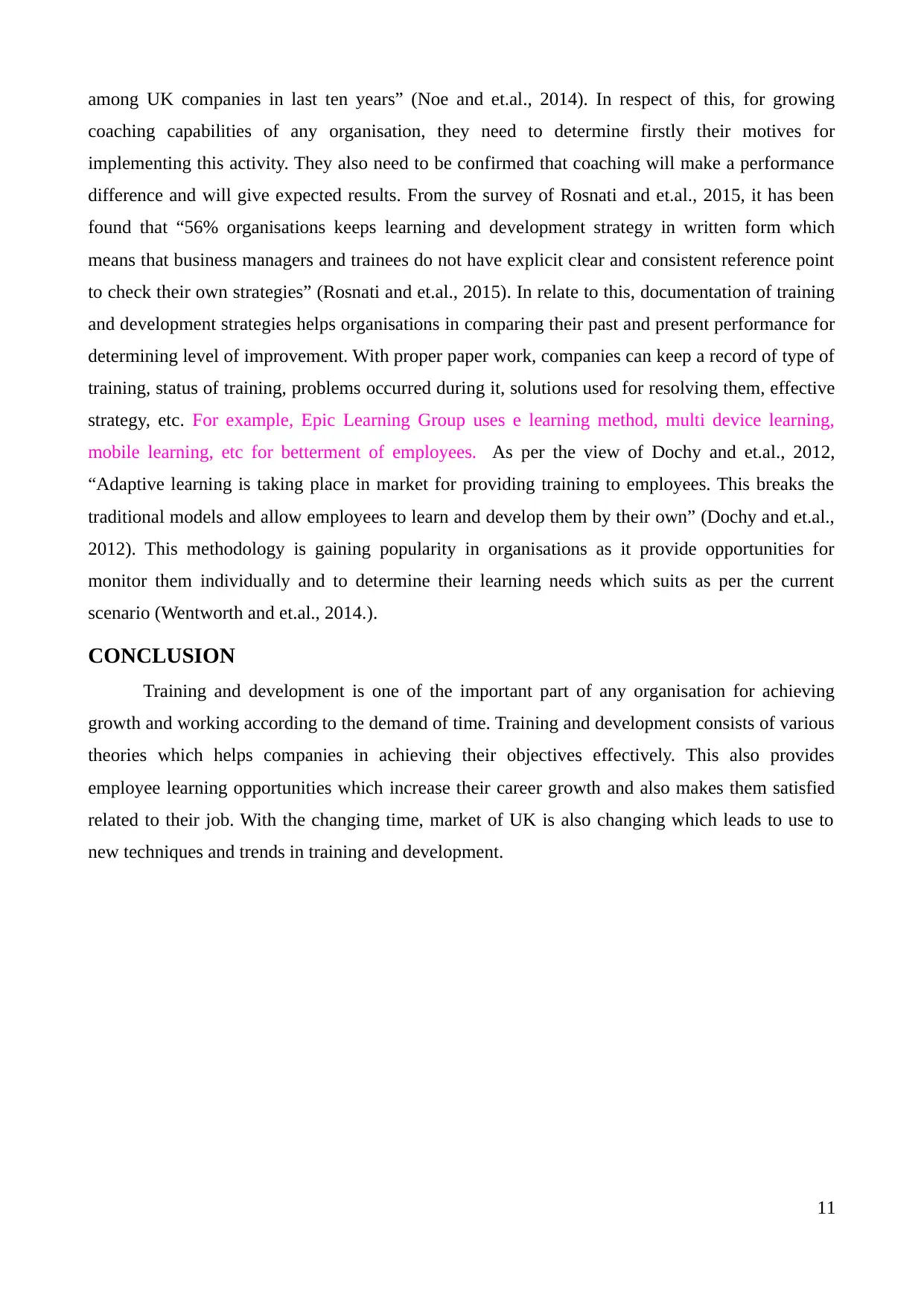
among UK companies in last ten years” (Noe and et.al., 2014). In respect of this, for growing
coaching capabilities of any organisation, they need to determine firstly their motives for
implementing this activity. They also need to be confirmed that coaching will make a performance
difference and will give expected results. From the survey of Rosnati and et.al., 2015, it has been
found that “56% organisations keeps learning and development strategy in written form which
means that business managers and trainees do not have explicit clear and consistent reference point
to check their own strategies” (Rosnati and et.al., 2015). In relate to this, documentation of training
and development strategies helps organisations in comparing their past and present performance for
determining level of improvement. With proper paper work, companies can keep a record of type of
training, status of training, problems occurred during it, solutions used for resolving them, effective
strategy, etc. For example, Epic Learning Group uses e learning method, multi device learning,
mobile learning, etc for betterment of employees. As per the view of Dochy and et.al., 2012,
“Adaptive learning is taking place in market for providing training to employees. This breaks the
traditional models and allow employees to learn and develop them by their own” (Dochy and et.al.,
2012). This methodology is gaining popularity in organisations as it provide opportunities for
monitor them individually and to determine their learning needs which suits as per the current
scenario (Wentworth and et.al., 2014.).
CONCLUSION
Training and development is one of the important part of any organisation for achieving
growth and working according to the demand of time. Training and development consists of various
theories which helps companies in achieving their objectives effectively. This also provides
employee learning opportunities which increase their career growth and also makes them satisfied
related to their job. With the changing time, market of UK is also changing which leads to use to
new techniques and trends in training and development.
11
coaching capabilities of any organisation, they need to determine firstly their motives for
implementing this activity. They also need to be confirmed that coaching will make a performance
difference and will give expected results. From the survey of Rosnati and et.al., 2015, it has been
found that “56% organisations keeps learning and development strategy in written form which
means that business managers and trainees do not have explicit clear and consistent reference point
to check their own strategies” (Rosnati and et.al., 2015). In relate to this, documentation of training
and development strategies helps organisations in comparing their past and present performance for
determining level of improvement. With proper paper work, companies can keep a record of type of
training, status of training, problems occurred during it, solutions used for resolving them, effective
strategy, etc. For example, Epic Learning Group uses e learning method, multi device learning,
mobile learning, etc for betterment of employees. As per the view of Dochy and et.al., 2012,
“Adaptive learning is taking place in market for providing training to employees. This breaks the
traditional models and allow employees to learn and develop them by their own” (Dochy and et.al.,
2012). This methodology is gaining popularity in organisations as it provide opportunities for
monitor them individually and to determine their learning needs which suits as per the current
scenario (Wentworth and et.al., 2014.).
CONCLUSION
Training and development is one of the important part of any organisation for achieving
growth and working according to the demand of time. Training and development consists of various
theories which helps companies in achieving their objectives effectively. This also provides
employee learning opportunities which increase their career growth and also makes them satisfied
related to their job. With the changing time, market of UK is also changing which leads to use to
new techniques and trends in training and development.
11

12
⊘ This is a preview!⊘
Do you want full access?
Subscribe today to unlock all pages.

Trusted by 1+ million students worldwide
1 out of 14
Related Documents
Your All-in-One AI-Powered Toolkit for Academic Success.
+13062052269
info@desklib.com
Available 24*7 on WhatsApp / Email
![[object Object]](/_next/static/media/star-bottom.7253800d.svg)
Unlock your academic potential
Copyright © 2020–2025 A2Z Services. All Rights Reserved. Developed and managed by ZUCOL.





